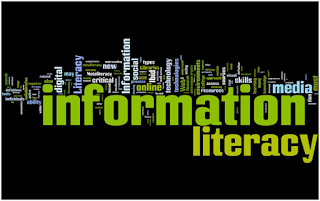A Different Approach to the One-Shot Bibliographic Instruction Session
The following is an email that I sent to one of my colleagues about one month ago. I wanted to share how I conducted my bibliographic instruction sessions for first year students.
At the next Instruction meeting, may I take a few minutes to
discuss how I conduct my bibliographic instruction sessions. Although I cover
the common student learning outcomes, I tend to contextualize my sessions with
a brief discussion about academic research as scholarly conversation. I begin
my session by asking students "What is research?" I want to know
student perceptions of academic research because I assume that these
perceptions inform how students respond to our library sessions and how they
actually use our databases I think students consider research to be the
collection of known facts into a document. Students seem to think that if they
find the right pieces they can put together an acceptable product. They seem to
think that knowledge is something out there waiting to be found, and that
almost all knowledge is easily retrievable via a Google or a proprietary
database search. My observations in the classroom and at the reference desk
seem to support my conclusions.
I constantly read Composition and Rhetoric scholarship,
especially the work of Gerald Graff and Cathy Birkenstein. Graff and
Birkenstein conclude that students will improve academically if they understand
the scholarly conversations that inform academic disciplines. My bibliographic
instruction sessions are informed by Graff and Birkenstein's work. During the
first ten minutes of class, I show students that academic research and scholarship are socially
constructed. Members of this society, scholars, often prefer to share their
constructions (research) through peer-reviewed journals. I don't uncritically
announce that peer-reviewed journals are the best sources, even for academic
assignments. I suggest that these are the spaces where scholars often converse
with each other. I suggest that their own research should be considered a part
of these conversations. Like any other conversations, they are not expected to
simply mimic the other participants. They are expected to respond to these
conversations, just as they do in non-academic conversations.
I then suggest that students use our databases to initially
listen and create a response (thesis statement) to these conversations. At this
point, I launch into an example of listening to conversations on a topic and
narrowing down the number of conversations I will focus on. After the
demonstration, I break up students into groups and have them search for
conversations based on questions I give them. I don't use the green sheets
because I find that students seem to waste 10-15 minutes trying to create a
thesis statement. During their presentations, I ask students questions about
their choices. In my future classes, I most likely will ask them to find
connections among the first 3 articles they discover. I want students
to think about possible connections, gaps, etc, that may lead to an interesting
thesis statement.
I think this approach will make student research efforts a
bit easier because they will already have the sources they need. Using this
approach, students will almost never say "I cannot find anything on my
topic" because their thesis statements will flow naturally from the
conversations. They will not have to distort or dismiss apparently irrelevant
conversations because they do not seem to support a predetermined thesis
statement. I suggest that they can use almost any conversation related to their
topic as long as they demonstrate a logical connection between the
conversations and their responses/thesis statements. I also emphasize this
approach because it helps them to use the conversations they have heard more
effectively, instead of searching for conversations that may not exist. I think
this approach will help them more effectively use limited resources after they
graduate.
I think our online modules mention academic research as scholarly conversation. If so, my sessions preview that information and helps creates an information/ academic library culture that facilitates a new relationship with information. I hope that students will see themselves as agents who construct knowledge and who actively critique, confirm, or complicate authority in their constructions. I think this approach enhances "critical thinking"--in every sense of that phrase.
Of course, I do not expect students to instantly adopt this
new relationship, especially during a one-shot instruction session. It is but a
small part of an academic library culture. I tend to reiterate this approach to
patrons at the research/reference desk. Recently, I used this method to help a
student start his literature review.
During my instruction sessions, I explain this approach to
the WRT 160 instructors. They seem to love it. In fact, several instructors
informed me that this is how WRT 160 is supposed to be taught according to a
departmental handbook.
In short, I use my sessions to facilitate an
academic library culture that encourages deep critical thinking. I
constantly try to get feedback to improve my methods. Of course, I use all my
teaching "powers" to engage students. It's a challenge that I love.


Comments
Post a Comment